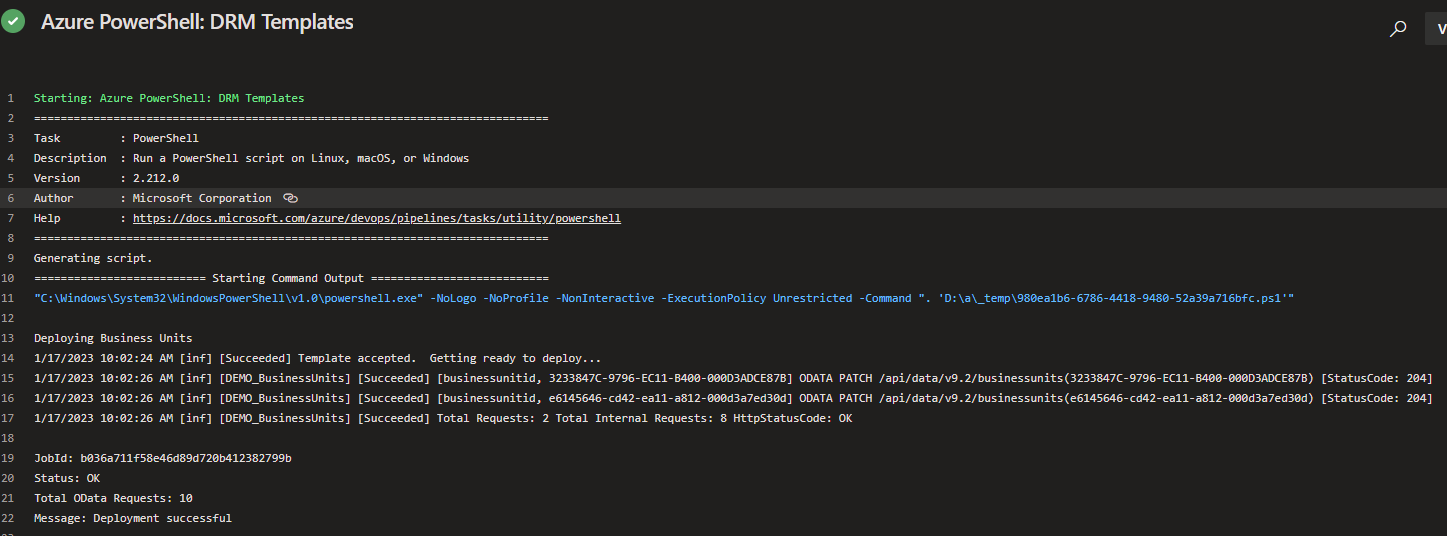ADO - Deploy DRM Templates
In this post we will show you how to execute template deployments using the PowerShell module. This example will deploy templates with parameters and we will also use an ADO variable group which that will contain the application registration client secret.
To deploy DRM templates in yaml pipelines you only need the PowerShell tasks below.
- powershell: |
Install-Module -Name Drm.Templates.Powershell -force -verbose
Import-Module -Name Drm.Templates.Powershell -verbose
displayName: 'PowerShell Install ''DRMTemplates'' Module'
- powershell: |
New-DrmDeployment -TemplateFile '$(System.DefaultWorkingDirectory)\platform-drm-demo\templates\demo_businessunits.json' -TemplateParameterFile '$(System.DefaultWorkingDirectory)\platform-drm-demo\parameters-stg\demo_businessunits.params.json' -TemplateParameterObject @{ 'drmclientSecret' = '$(drmclientSecret)' }
displayName: 'PowerShell: DRM BusinessUnits'
Follow the document for a complete pipeline that is executable.
Prerequisites
Before setting up your pipeline you will need to create a repo to hold the following items
- An ADO instance.
- DRM Templates - Click here for recommendations on file structure
To create a repo in ADO follow this guide from Microsoft
Repository setup
As per the prerequisites you should have in place the repository.
The file layout is up to you but in this walkthrough you can see the structure we have below.

Drm Templates
For our example we have one environment we are deploying to which is staging (stg).
The parameters and templates are all held under the parent folder 'platform-drm-demo'

The connection to the Dynamic environment will done by an application registration. Click here to see how to connect to a Dynamics environment using an application registration.
Note
If you wanted to introduce a new Dynamics environment to configure, just add a new parameters-<env> folder.
Variable group
For this walkthrough we will also be using a variable group which contains one value drmclientSecret.
This variable group will be used by the pipeline and the drmclientSecret value passed to the template
as a parameter override.

Yaml Pipeline
To deploy DRM templates we will use the PowerShell module Drm.Templates.Powershell.
The pipeline will install the module from PowerShell gallery then call New-DrmDeployment to deploy
the template.
Note
To deploy DRM templates you will need to use a vmImage of 'windows-latest'. The PowerShell module only runs on PowerShell Desktop version 5.1 upwards. It doesn't support PowerShell Core yet.
The pipeline below will do the following things
- Check out the repository to the build agent, this makes available the templates and parameters.
- Install and Import the PowerShell module
Drm.Templates.Powershell. - Execute the template using the Cmdlet New-DrmDeployment.
In the example below we are only deploying the business unit template, to deploy the others
you would repeat the powershell task and update the relevant properties with template and
parameter locations.
trigger: none
stages:
- stage: drm_tst_deploy
jobs:
- deployment: tst_deploy
pool:
vmImage: 'windows-latest'
environment: 'Drm-Test'
variables:
- group: 'devops-drmtemplates-tst'
strategy:
runOnce:
deploy:
steps:
- checkout: self
clean: false
- powershell: |
Install-Module -Name Drm.Templates.Powershell -force -verbose
Import-Module -Name Drm.Templates.Powershell -verbose
displayName: 'PowerShell Install ''DRMTemplates'' Module'
- powershell: |
New-DrmDeployment -TemplateFile '$(System.DefaultWorkingDirectory)\platform-drm-demo\templates\demo_businessunits.json' -TemplateParameterFile '$(System.DefaultWorkingDirectory)\platform-drm-demo\parameters-stg\demo_businessunits.params.json' -TemplateParameterObject @{ 'drmclientSecret' = '$(drmclientSecret)' }
displayName: 'PowerShell: DRM BusinessUnits'
Overriding parameters using ADO variables
Let's breakdown the New-DrmDeployment command.
New-DrmDeployment
-TemplateFile '$(System.DefaultWorkingDirectory)\platform-drm-demo\templates\demo_businessunits.json'
-TemplateParameterFile '$(System.DefaultWorkingDirectory)\platform-drm-demo\parameters-stg\demo_businessunits.params.json'
-TemplateParameterObject @{ 'drmclientSecret' = '$(drmclientSecret)' }
We reference the -TemplateFile and -TemplateParameterFile as normal.
By adding -TemplateParameterObject we are overriding the 'drmclientSecret' drm parameter with the variable group value
'$(drmclientSecret)'.
Pipeline output
Running the pipeline above would generate output similar to the following.

If a deployment is successful it will output each patch or post request made to the odata api and also return the total requests made.